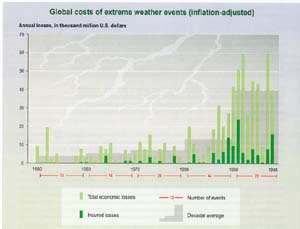| 2.25
|
There are preliminary indications that some human
systems have been affected by recent increases in floods and droughts.
The rising socio-economic costs related to weather damage and to regional
variations in climate suggest increasing vulnerability to climate change
(see Table 2-1).
|
|
| 2.26 |
Extreme weather or climatic events cause
substantial, and increasing, damage. Extreme events are currently
a major source of climate-related impacts. For example, heavy losses of
human life, property damage, and other environmental damages were recorded
during the El Niño event of the years 1997-1998. The impacts
of climatic extremes and variability are a major concern. Preliminary indications
suggest that some social and economic systems have been affected by recent
increases in floods and droughts, with increases in economic losses for
catastrophic weather events. Because these systems are also affected by
changes in socio-economic factors such as demographic shifts and land-use
changes, quantifying the relative impacts of climate change (either anthropogenic
or natural) and of socio-economic factors is difficult. For example, direct
costs of global catastrophic weather-related losses, corrected for inflation,
have risen an order of magnitude from the 1950s to the 1990s (see Figure
2-7), and costs for non-catastrophic weather events have grown similarly.
The number of weather-related catastrophic events has risen three times
faster than the number of non-weather-related events, despite generally
enhanced disaster preparedness. Part of this observed upward trend in weather-related
losses over the past 50 years is linked to socio-economic factors (e.g.,
population growth, increased wealth, urbanization in vulnerable areas),
and part is linked to regional climatic factors (e.g., changes in precipitation,
flooding events).
|
 WGII TAR SPM & WGII
TAR Sections 8.2 & 14.3
WGII TAR SPM & WGII
TAR Sections 8.2 & 14.3 |
| 2.27 |
The fraction of weather-related losses
covered by insurance varies considerably by region, and the uneven
impacts of climatic hazards raise issues for development and equity. Insurers
pay only 5% of total economic losses today in Asia and South America, 10%
in Africa, and about 30% in Australia, Europe, and North and Central America.
The fraction covered is typically much higher when just storm losses are
considered, but flood-and crop-related losses have much lower coverage.
The balance of the losses are absorbed by governments and affected individuals
and organizations.
|
 WGII
TAR Sections 8.3.3.1 & 8.5.4 WGII
TAR Sections 8.3.3.1 & 8.5.4 |
| 2.28 |
Climate-related health effects are observed.
Many vector-, food-, and water-borne infectious diseases are known
to be sensitive to changes in climatic conditions. Extensive experience
makes clear that any increase in floods will increase the risk of drowning,
diarrheal and respiratory diseases, water-contamination diseases, and -- in
developing countries -- hunger and malnutrition (high confidence).
Heat waves in Europe and North America are associated with a significant
increase in urban mortality, but warmer wintertime temperatures also result
in reduced wintertime mortality. In some cases health effects are clearly
related to recent climate changes, such as in Sweden where tick-borne encephalitis
incidence increased after milder winters and moved northward following the
increased frequency of milder winters over the years 1980 to 1994.
|
 WGII TAR SPM & WGII
TAR Sections 9.5.1, 9.7.8,
10.2.4, & 13.2.5
WGII TAR SPM & WGII
TAR Sections 9.5.1, 9.7.8,
10.2.4, & 13.2.5 |
| 2.29 |
The recognition and anticipation of adverse
impacts of climate change has led to both public and governmental responses.
|
|
| 2.30 |
As a consequence of observed and anticipated
climate change, socio-economic and policy responses have occurred in the
last decade. These have included stimulation of the renewable energy
market, development of energy-efficiency improvement programs enhanced by
climate change concerns, integration of climate policies into broader national
policies, carbon taxes in several countries, domestic greenhouse gases trading
regimes in some countries, national and international voluntary agreements
with industries to increase energy efficiency or otherwise decrease greenhouse
gas emissions, creation of carbon exchange markets, public and political
pressures for utilities to reduce or offset carbon emissions from new energy
projects, industry reconnaissance into approaches to offset carbon emissions,
and establishment of programs to assist the developing and least developed
countries reduce vulnerabilities and adapt to climate change and engage
in mitigation activities.
|
 WGIII TAR Sections 3.2, 3.4-5,
3.8.4, 6.2.2,
6.3.2, & 9.2.1
WGIII TAR Sections 3.2, 3.4-5,
3.8.4, 6.2.2,
6.3.2, & 9.2.1 |
|
Figure 2-7: The economic losses from catastrophic weather events
have risen globally 10-fold (inflation-adjusted) from the 1950s to the 1990s,
much faster than can be accounted for with simple inflation. The
insured portion of these losses rose from a negligible level to about 23%
in the 1990s. The total losses from small, non-catastrophic weather-related
events (not included here) are similar. Part of this observed upward trend
in weather-related disaster losses over the past 50 years is linked to socio-economic
factors (e.g., population growth, increased wealth, urbanization in vulnerable
areas), and part is linked to regional climatic factors (e.g., changes in
precipitation, flooding events). |
 WGII TAR Figure 8-1
WGII TAR Figure 8-1 |
